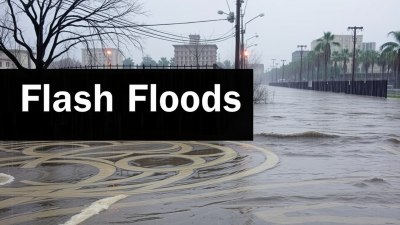What Causes Flash Floods So Quickly
Explore the rapid onset of flash floods, their causes, and how understanding them can improve safety and preparedness.

Image created with Flux Schnell
Flash floods are among the most dangerous and sudden natural disasters, often occurring with little warning and causing significant damage. Understanding what causes flash floods so quickly is crucial for improving early warning systems, preparing communities, and mitigating risks associated with these extreme events.
Definition and Characteristics of Flash Floods
A flash flood is a rapid flooding of low-lying areas, typically caused by intense rainfall over a short period. Unlike typical river flooding that may take days to develop, flash floods can develop in minutes to a few hours, making them particularly hazardous. These floods often occur downstream of mountainous or hilly terrain or in urban areas where drainage is inadequate.
Primary Causes of Flash Floods
The swift onset of flash floods stems from several natural and human-related factors that combine to produce sudden high-volume water flows. The principal causes include:
1. Intense or Prolonged Rainfall
One of the most common causes of flash floods is heavy rainfall occurring in a very short time. When rain intensities exceed the infiltration capacity of the soil, water quickly accumulates, leading to rapid runoff. Thunderstorms, especially those that are stationary or slow-moving, can dump several inches of rain in an hour, overwhelming local waterways and drainage systems.
2. Topography
Steep mountainous terrain or hilly landscapes channel rainwater rapidly into valleys, creeks, and rivers. The slope creates a natural funnel effect, concentrating the flow and raising water levels rapidly. Narrow canyons and dry stream beds known as arroyos or wadis can fill suddenly, transforming tranquil landscapes into flash flood zones.
3. Soil Saturation Levels
Prior soil moisture conditions greatly affect flash flood risk. Soils that are already saturated from previous rains or snowmelt cannot absorb additional water, resulting in extensive surface runoff. In contrast, dry soils initially absorb water, but if rainfall continues or is too intense, they reach saturation quickly, triggering fast runoff.
4. Urbanization and Land Use Changes
Urban areas exacerbate flash flooding due to the proliferation of impermeable surfaces like roads, buildings, and parking lots. These surfaces prevent water from infiltrating the ground, boosting runoff volumes. Storm drains can become overwhelmed during heavy rainfall, leading to rapid urban flooding. Furthermore, deforestation and land degradation reduce natural water retention, increasing runoff and flood potential.
5. Dam or Levee Failures
Although less common, structural failures in dams or levees can cause sudden. abrupt flooding downstream. These events mirror flash floods in their rapid onset and destructive capability, often catching communities unprepared.
The Hydrological Process Behind Flash Flooding
At the core of flash floods is the hydrological response of the landscape to rainfall. When rain falls, a portion of it infiltrates the soil, some evaporates, and the remainder flows over the surface as runoff. Flash floods occur when the balance tips heavily toward runoff because the rainfall rate exceeds infiltration or storage capacities.
Runoff concentrates in small channels that quickly converge into larger streams or rivers. In steep areas, water gains momentum as it cascades downhill, increasing velocity and erosive power. This buildup happens extremely fast, often within minutes after intense rainfall starts. The accumulation in narrow riverbeds causes water levels to rise dramatically and flood surrounding areas suddenly.
Weather Patterns Leading to Flash Flood Conditions
Certain meteorological conditions are more likely to produce the heavy rainfall responsible for flash flooding:
Convective Thunderstorms: These storms develop rapidly with strong upward air currents, generating intense localized rainfall. If the storm stalls or moves slowly, the rainfall concentrates over a small area, raising flash flood risk.
Tropical Cyclones and Hurricanes: Remnants of tropical systems often bring intense rain over wide regions. The combination of already saturated soils and continuous heavy rain significantly increases flash flood potential.
Cold Fronts and Atmospheric Rivers: These systems can funnel large moisture loads into a region, triggering prolonged periods of rain that may lead to sudden flooding.
The Role of Soil and Geology in Flash Flood Dynamics
Soil type influences how much rainwater infiltrates versus runs off. Sandy soils typically allow more infiltration, reducing runoff, whereas clayey or compacted soils impede water absorption, boosting surface flow. Additionally, rocky or impermeable geological formations promote rapid runoff, as water cannot penetrate deeply. Areas with thin soil layers over bedrock are particularly vulnerable to flash floods.
Human Impacts That Accelerate Flash Flood Risks
Human activities often unknowingly increase the speed and severity of flash floods:
Urban Development: Increasing impervious surfaces makes natural absorption difficult. Stormwater drainage systems may not handle extreme rainfall, leading to fast water accumulation.
Deforestation: Tree roots normally help absorb and slow runoff. Removing vegetation reduces this buffering, increasing flood speed.
Agricultural Practices: Certain farming methods can compact soil or reduce ground cover, both of which elevate runoff rates.
Land Subsidence: In some regions, groundwater extraction causes the ground to sink, creating depressions that retain water and worsen flooding during heavy rains.
Flash Flood Warning and Prediction Challenges
The rapid development of flash floods poses significant challenges for forecasting and issuing timely warnings. Meteorologists rely on radar data and rain gauges to monitor precipitation intensity. However, predicting exactly where and when rainfall will trigger a flash flood remains difficult due to the extreme variability of storms and local terrain differences.
Hydrological models help estimate runoff and flood risk but require accurate, high-resolution data on soil conditions, topography, and land use. Even with the best technology, the very short lead times—often under an hour—mean that personal vigilance and knowledge are essential for safety.
Impacts of Flash Floods on Communities and Infrastructure
Flash floods can cause widespread destruction to homes, roads, bridges, and utilities. Due to their sudden nature, they often catch people off guard. Driving through flooded roads is a common cause of death and injury during these events. In rural areas, flash floods can damage farmland and disrupt supplies. Urban flash floods can paralyze cities with traffic congestion, power outages, and water contamination.
Safety Measures and Preparedness for Flash Floods
Given the quick onset of flash floods, preparation and awareness are vital. Some key recommendations include:
- Stay informed with local weather alerts and understand flood-prone areas.
- Avoid low-lying regions or dry creeks during storms.
- Do not attempt to drive through flooded roads (“Turn Around Don’t Drown”).
- Have an emergency kit and evacuation plan ready.
- Support community efforts to improve infrastructure and natural buffers.
Engineering Solutions to Mitigate Flash Flood Risks
Communities can implement various infrastructure improvements to reduce the impact of flash floods. These include stormwater retention basins, improved drainage systems, flood barriers, and green infrastructure like permeable pavements and vegetated swales. Managing watershed health through reforestation and soil conservation also helps slow runoff.
Case Studies Illustrating Rapid Flash Flood Formation
Numerous flash flood incidents around the world highlight how quickly these events unfold. For example, the 2013 Colorado floods began after intense rain in mountainous terrain saturated soils and rapidly filled river channels, damaging thousands of homes. Similarly, urban flash floods in Houston, Texas, during Hurricane Harvey overwhelmed drainage systems within hours.
These cases demonstrate how a combination of heavy rainfall, terrain, and human factors converge to produce sudden, life-threatening floods.
Importance of Community Education and Early Warning Systems
Improving public understanding of flash floods and promoting preparedness can save lives. Emergency management agencies work to deploy early warning systems using weather radar, river gauges, and communication networks. Educating residents about flash flood risks and proper responses helps reduce hazardous behavior during flood events.
Personal awareness, such as recognizing warning signs like rapidly rising water or unusual storm severity, is crucial when official alerts are delayed or unavailable.
Environmental and Climate Change Considerations
Increasing global temperatures influence weather patterns and may lead to more frequent and intense rain events. This amplifies the risk of flash flooding in many regions. Changes in land use driven by expanding urban areas also contribute to degradation of natural flood buffers. Understanding these trends is essential for long-term planning and resilience building.
Climate models project that some areas may experience intensified thunderstorm activity and heavier precipitation, heightening concerns about flash flood hazards.
Technological Innovations in Flash Flood Monitoring
Advancements in technology improve flash flood forecasting and response. High-resolution weather radar, satellite imagery, and real-time sensors enhance detection of rapid rainfall accumulation. Mobile apps and SMS alerts increase community reach for warnings. Machine learning algorithms help interpret complex weather data to identify potential flash flood risks earlier.
These innovations support emergency responders and help save lives by providing timely information.
The Psychological Impact of Flash Flood Events
Beyond physical damage, flash floods can produce lasting trauma for affected individuals. The sudden loss of property, disruption of daily life, and potential for injury induce stress and anxiety. Mental health support and community cohesion initiatives are important components of recovery efforts following flash flood disasters.
Awareness of these impacts emphasizes the need for comprehensive disaster management that includes psychological care.
Key Factors Leading to Rapid Flash Floods
Flash floods develop quickly due to the interplay of intense rainfall, terrain steepness, soil conditions, and human alterations to the environment. High-intensity storms produce water volumes that overwhelm infiltration and drainage capacity, with topography funneling runoff into confined channels. Urbanization and soil saturation further accelerate flood formation. Early warning and education remain essential to reduce exposure to these swift, dangerous floods.











